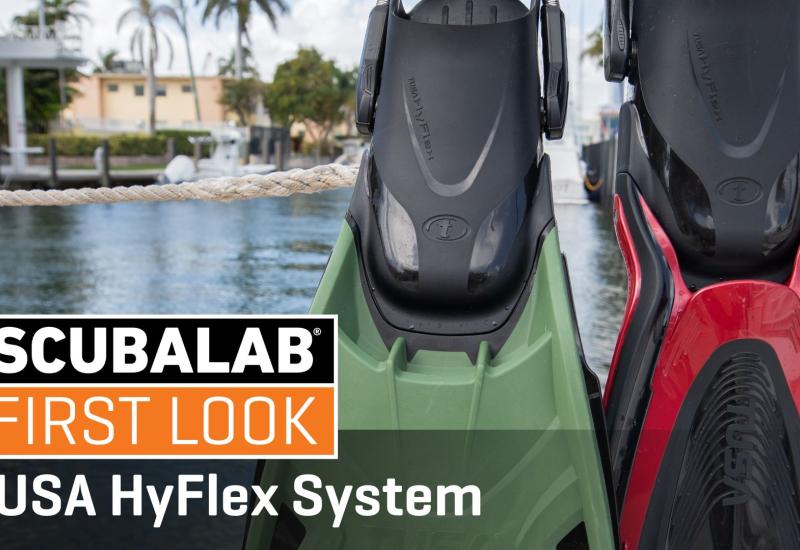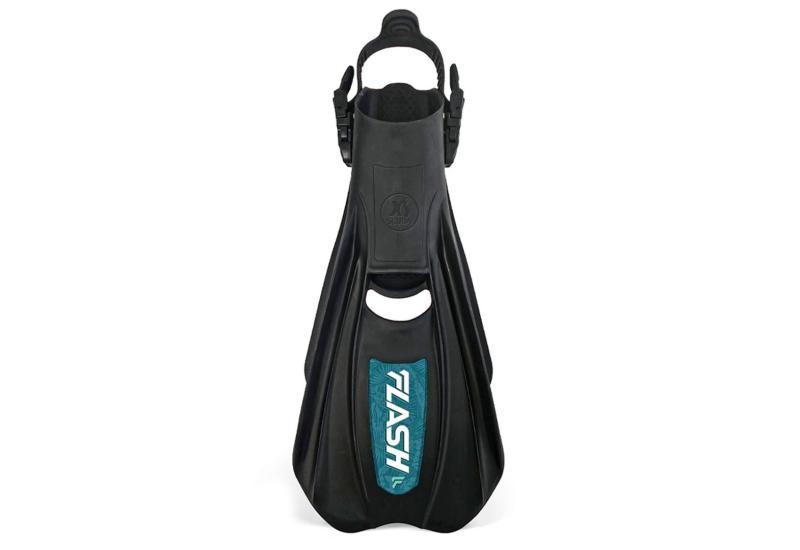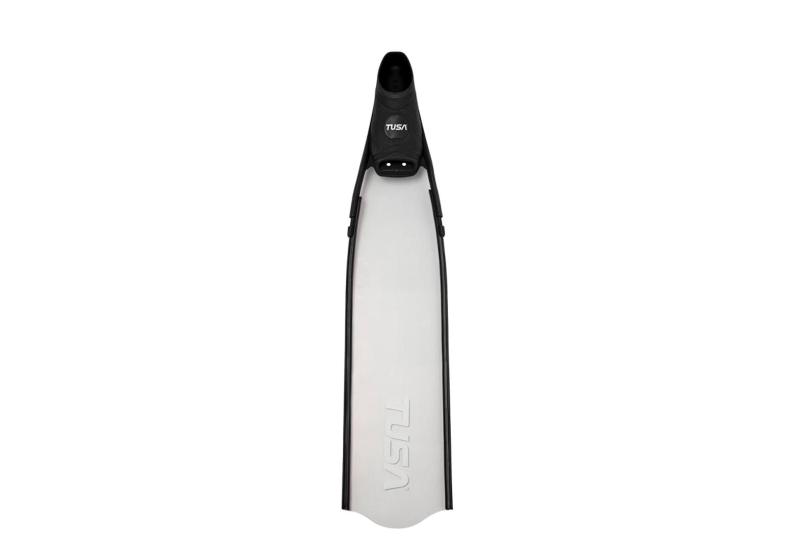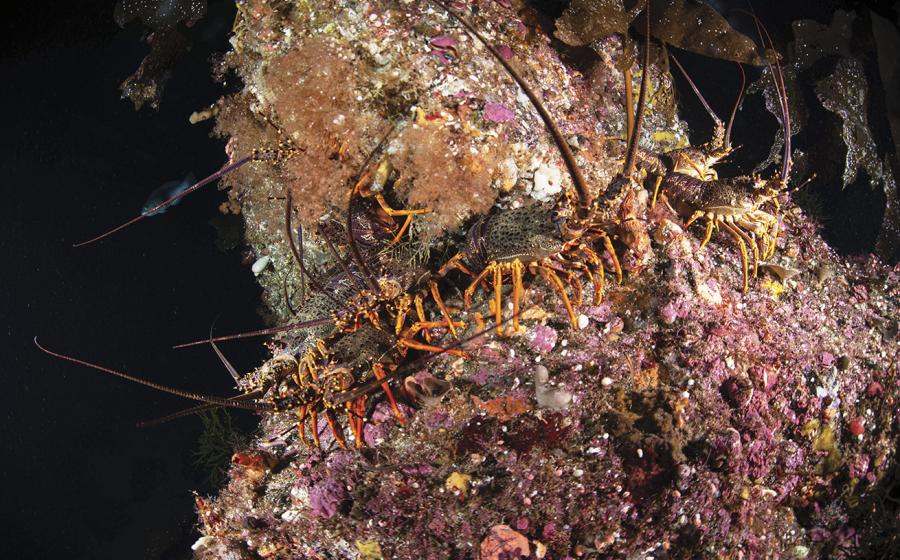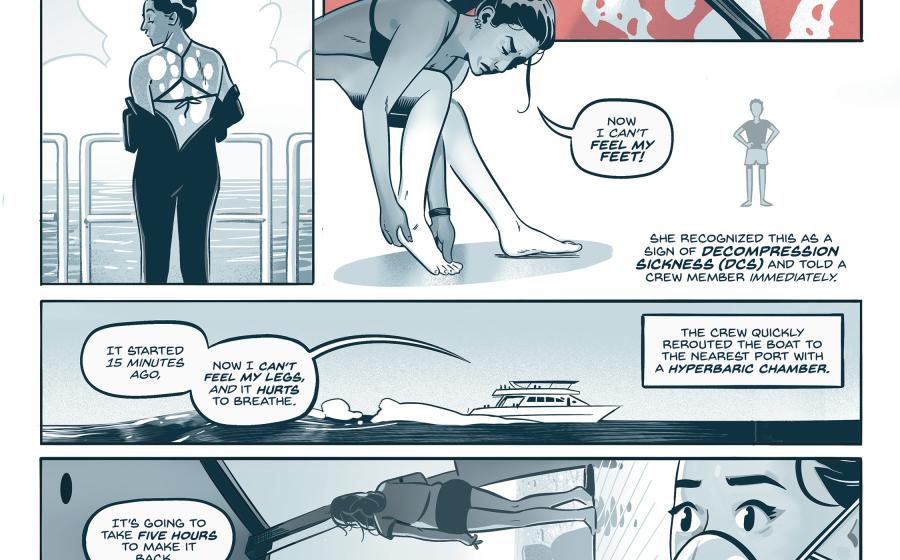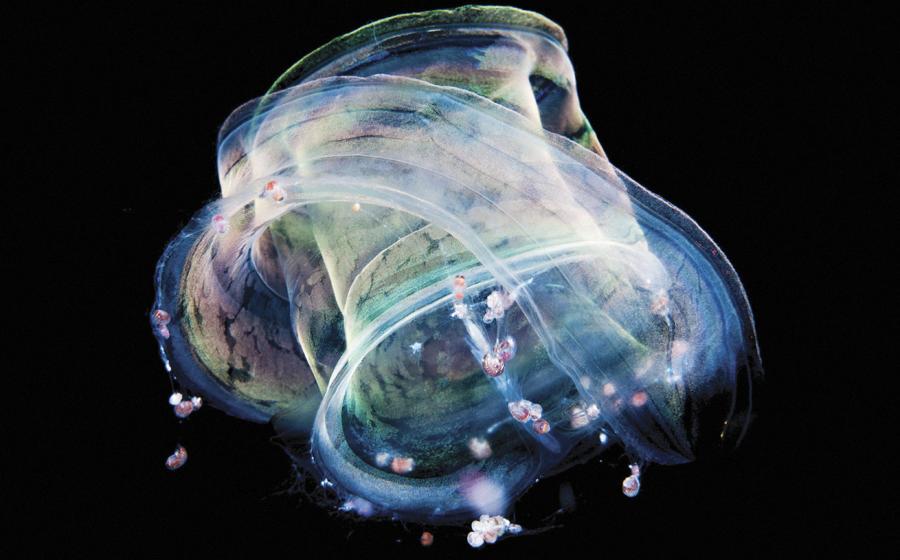Rumble in the Jungle: Scuba Fin Smackdown
July 2002
Fins Reviewed in This Article
| AERIS Velocity APOLLO SPORTS Bio-Fin Pro AQUA LUNG Blades II AQUA LUNG V-Tek ATOMIC AQUATICS Splitfin | DACOR Panther OCEANIC Caribe OCEANIC Vortex V-12 SCUBAPRO Twin Jet TUSA SF-8 X-Pert Zoom |
In late December 2001, Scuba Diving put out the word on www.scubadiving.com that we were looking for a few good divers--physically fit, reasonably experienced, with glass-half-full, go-get-'em attitudes. The mission: to accompany Scuba Lab to the Central American island of Guanaja to participate in the testing of this year's crop of scuba fins.
This was not a tropical vacation we were organizing. Like all Scuba Lab tests, it was a serious attempt to gather reliable objective and subjective data in order to draw performance conclusions on a category of diving gear; in this case, scuba fins. In other words, this was going to be hard work. But despite our warnings that participants could plan on breaking a serious sweat, in only three weeks we received close to 600 applications from diving enthusiasts eager to fill the 12 available test diver spots.
After reviewing each application, selections were made, and last February nine men and three women, ranging in age from 29 to 58, hailing from California to Rhode Island, from North Dakota to Texas, arrived at the airport in San Pedro Sula, Honduras. They included a college professor, a computer consultant, a marine biologist, an engineer, a NASA training diver and an officer in the U.S. Army, to name just a few. Armed with C-cards ranging in age from 18 months to three decades, they were bringing to the project a total of 117 years of diving experience and 6,250 dives under their collective weight belts.
THE TREK
Humping dive gear along with four big boxes of scuba fins, our test divers crowded into a small prop plane that flew them from San Pedro Sula to the coastal town of La Ceiba, where they transferred to an even smaller plane for the 70-mile over-water flight to Guanaja. From there, they boarded the dive boat Nimitz and cast off for a real-life jungle cruise to the other side of the island and the Bayman Bay Club dive resort, our gracious host for this grand experiment.
Guanaja is a quiet island, with craggy mountains, storybook waterfalls and lush, tropical growth. There are no roads, no crowds--not much of anything, in fact, but squawking jungle birds and, most importantly, an incredible coastline. The perfect place to do some serious diving.
WHO ARE THESE GUYS?
Our 12 test divers hail from across the country and have a wide variety of backgrounds, physical fitness and diving experience. Out of close to 600 applicants, why were they chosen?
In a word, attitude. Every one of these divers made it crystal-clear in their resumes that they were ready, willing and able to do whatever was necessary to get the job done. They vowed to work hard, to take the tests seriously, and to maintain a good sense of humor--and they proved good to their word. We simply could not have picked a better test team, either amateur or professional.
Here they are:
| JAMES "JD" BARNETT Age: 51. Occupation: Chemical engineer. Hometown: Farmington, N.M. Years Diving: 32. | CHRIS CAKA Age: 32. Occupation: NASA diver. Hometown: Seabrook, Texas. Years Diving: 14. | MARK EVANS Age: 31. Occupation: Captain, U.S. Army. Hometown: Vallejo, Calif. Years Diving: 4. |
| JIM GRIER Age: 58. Occupation: College professor. Hometown: Fargo, N.D. Years Diving: 11. | CATHY HAMILTON Age: 40. Occupation: Computer consultant. Hometown: Killeen, Texas. Years Diving: 17. | JEFF LOVIN Age: 29. Occupation: Computer support. Hometown: Costa Mesa, Calif. Years Diving: 2. |
| CHRIS "CP" PARSONS Age: 39. Occupation: Software development consultant. Hometown: Austin, Texas. Years Diving: 2. | ERIN RECHISKY Age: 29. Occupation: Occupation: Marine biologist Hometown: Narragansett, R.I. Years Diving: 9. | POLLY SHAW Age: 33. Occupation: Energy policy analyst. Hometown: San Francisco, Calif. Years Diving: 4. |
| DONALD VICTORIAN Age: 54. Occupation: Petroleum chemist. Hometown: Kenner, La. Years Diving: 4. | SCOTT WERTMAN Age: 41. Occupation: Automotive business owner. Hometown: Upper St. Clair, Pa. Years Diving: 15. | JOHN WHEELER Age: 43. Occupation: Senior account executive. Hometown: Pembroke Pines, Fla. Years Diving: 6. |
THE PLAN
We had five days to complete our mission. One day for practicing test protocols, followed by four days of data gathering. Mornings were spent conducting rigorous speed and efficiency runs as well as alternate kick and towing tests. Then, after lunch, test divers were assigned two pairs of fins and sent out to do some boat diving. Test fins were subjected to the rigors of typical recreational diving: exploring sunken wrecks, poking about in caves, cruising reefs, shooting photos. Afterward, evaluation sheets were filled out and comments were noted.
After all was said and done, each fin in the test group was subjected to a total of 24 to 28 hours of intensive in-water testing (16 hours of objective tests, eight to 12 hours of real-life diving). Here's what our test divers discovered.
IN A NUTSHELL
-
Other things being equal (like foot pockets), split fins tend to be both faster and more efficient than paddle fins.
-
Among the 11 fins tested, full-foot fins, regardless of blade type, were faster than adjustable fins. They were also more efficient.
-
Top speed generally correlates with efficiency. The fastest fin is also the most efficient. The slowest is least efficient. In between, the correlation is not quite as exact.
How We Tested Them
TESTING FOR EFFICIENCY
For purposes of this and past testing, we've defined the most efficient fins as those that allow a diver to swim a measured course at a constant speed with the smallest expenditure of energy.
The test protocol included:
-
A standard underwater course (150 feet out, 150 feet back), run at a steady speed of 1 mph, set at a controlled depth indicated by a thin cord marked with ribbons at the start, finish, as well as at nine "milestones" in between. These ribbons were spaced such that a test diver would pass them at 10-second intervals. Each test diver held a two-and-one-half-foot length of PVC pipe, crosswise like a kayak paddle. A slate and stopwatch were attached to the pipe where they could be easily seen. The end of the pipe was used as a pointer to track along the cord, enabling test divers to control depth to within a few inches.
-
The first morning of the test schedule was devoted to practicing running the course. However, test divers reported this system easy to use and were providing repeatable results after only one hour of practice.
-
Each diver wore the same dive gear, swam at the same speed, over the same distance, at the same depth, for each run. During surface intervals, each diver reported time and amount of air used, switched fins, then rested three to five minutes before embarking on the next run.
-
Each of the 11 fins was tested six times by each of six divers over a period of four days (three outbound runs and three return runs per diver per fin. Total: 396 separate efficiency course runs, or 66 per diver).
-
Using human testers is difficult because their fitness, energy and accuracy vary from day to day. But by compiling hundreds of test runs, anomalies can be eliminated and clear trends can be established.
TESTING FOR SPEED
Speed is not necessarily a priority while swimming under water, as it costs dearly in energy and air consumption (to double your speed, you have to at least quadruple your effort). Still, it's a good indication of a fin's efficiency. So using underwater speedometers, six divers wearing full scuba gear each tested 11 fins for top speed at a depth of approximately 15 feet using the primary flutter kick as well as alternative frog and dolphin kicks. Each diver tested each fin three times with each kick, for a total of 594 individual speed tests, or 54 per fin.
REAL-WORLD PERFORMANCE: THE MEAT OF THE MATTER
Efficiency and speed are clearly important indicators for determining how well a fin performs, but this data only paints half the picture.
As test diver CP Parsons puts it, "There's a line you can draw separating fins that offer acceptable efficiency and speed performance from fins that don't. Once you determine this line and discard the fins that don't make the cut, any fin-buying decisions should be based on comfort, fit and real-world performance in actual sport diving conditions, not on an efficiency course or holding a speedometer."
We agree. That is why overall performance rankings are based upon 25 percent efficiency scores, 25 percent speed scores, and 50 percent subjective scores based on real-world diving.
Subjective evaluations were based on 15 subjective criteria, incorporating both numerical scores and written comments. Criteria included:
-
Sizing, fit and comfort of the foot pocket. In and out of the water.
-
Ease of getting in and out of. Prior to the dive, after the dive, while on deck.
-
Buckles and straps; attachment and adjustment. Ease of operating buckles; ease of attaching, detaching or adjusting straps, both in and out of the water.
-
Surface swimming. Both face-down and on one's back.
-
Changing speeds. During an underwater swim, the ease of repeatedly speeding up and slowing down.
-
Changing direction. During an underwater swim, the ease of repeatedly changing direction or quickly reversing direction.
-
Different kicks. Ease and effectiveness of flutter, frog, dolphin and sculling kicks.
-
Stability. How much the fins wobble, slice from side to side or hit each other during the kick cycle.
-
Power vs. Stress. Perception of power produced vs. effort required.
-
Stiffness. Perception of fin blade flexibility.
-
Removal of fins. Ease of removing fins in the water or on a swim step.
-
Effectiveness of nonskid materials. Sense of security on a wet boat deck fully geared up while wearing fins.
-
Ease of kick. Whether or not fins are conducive to an easy fin kick.
-
Ease of maintaining speed. Whether or not fins make it easy to hold a certain speed.
-
Muscle strain. Whether or not fins create a marked strain on leg muscles when trying to maintain a reasonable kicking motion.
How We Got the Totals
The total score is 25 percent speed, 25 percent efficiency and 50 percent subjective (sizing, fit and comfort, ease of donning and doffing, buckles and straps, attachment and adjustment, surface swimming, changing speeds, changing direction, different kicks, stability, power vs. stress, stiffness, removal, nonskid material, ease of kick, ease of maintaining speed, muscle strain). To get the total score, we added the speed score, the efficiency score, and twice the subjective score.
| MANUFACTURER & MODEL | SPEED TEST | EFFICIENCY | SUBJECTIVE | TOTAL |
| **ADJUSTABLE FINS ** | ||||
| APOLLO SPORTS Bio-Fin Pro | 3.5 | 3 | 4.1 | 14.7 |
| AQUA LUNG Blades II | 3.0 | 2 | 3.1 | 11.2 |
| AQUA LUNG V-Tek | 2.7 | 2 | 3.1 | 11.2 |
| ATOMIC AQUATICS Splitfin | 3.2 | 3 | 4.0 | 14.2 |
| DACOR Panther | 1.5 | 2 | 2.9 | 9.3 |
| OCEANIC Vortex V-12 | 3.2 | 3 | 3.5 | 13.2 |
| SCUBAPRO Twin Jet | 2.0 | 3 | 3.6 | 12.0 |
| TUSA SF-8 X-Pert Zoom | 3.0 | 3 | 3.6 | 13.2 |
| FULL-FOOT FINS | ||||
| AERIS Velocity | 4.0 | 4 | 4.0 | 16.0 |
| CRESSI-SUB Pro Star | 4.0 | 4 | 3.4 | 14.8 |
| OCEANIC Caribe | 4.7 | 4 | 3.9 | 16.5 |
| RATING SYSTEM 5=Excellent, 4=Very Good, 3=Good, 2=Fair, 1=Poor |
Adjustable Fins
Past Performers: Adjustable Fins
These adjustable fins received Testers' Choice awards in previous fin tests and are still on the market.
AERIS VELOCITY
CRESSI-SUB PRO LIGHT
DACOR TIGER
GENESIS SCUBA BLITZ
MARES VOLO
SCUBAPRO TWIN JET GRAPHITE
SHERWOOD SCUBA TREK
{mospagebreak} APOLLO BIO-FIN PRO
||
|---|
|

|
| Apollo Bio Fin Pro|
A top performer in speed, efficiency and real-world diving, Apollo's Bio-Fin Pro earns the title of best overall adjustable fin in this test go-round. The fin is made of all-natural rubber, which not only gives the somewhat smaller fin blade its snap, but also makes it comfortable. The flexible propeller blade can seem somewhat flimsy until you get used to it. But after a little practice, it proves to be an extremely stable, maneuverable fin that moves you through the water with minimal muscle strain. One of the fastest adjustable fins in the flutter kick, the Bio-Fin Pro also generated good speeds using frog and dolphin kicks and ranked among the top fins for towing a diver on the surface.Test divers found the Bio-Fin Pro to have an excellent foot pocket. The fin is very easy to don and doff, especially in the water, helped by a handy open loop on the strap. Its buckles also earned high marks.
PRICE: $190, original black; $200, metallic blue.
FIN STYLE: Split.
BUOYANCY IN SALT WATER: Negative.
FOOT POCKETS: Open toe.
RELATIVE STIFFNESS: Less stiff than average.
BLADE SIZE: Smaller than average.
AVAILABLE SIZES: 5.
COLORS: 2.
MADE IN: Japan.
STRENGTHS: Good range of sizes. Comfortable foot pocket. Ease of kick. Minimal muscle strain. High power vs. stress ratio. Highly maneuverable. Easy to don and doff.
WEAKNESSES: None.
For More Information
APOLLO SPORTS USA (800) 231-0909; web: www.apollosportsusa.com
AQUA LUNG BLADES II
||
|---|
|

|
| Aqua Lung Blades II|
Aqua Lung's Blades II is a total redesign of its popular and highly rated Blades fin. Unfortunately, the new combination of polymer plastic and rubber construction found in the Blades II results in what is described as a too-stiff fin with a too-soft foot pocket. Based on test results, this is not a good combination if you're striving for performance.With a fin blade built on top of the foot pocket, the Blades II earns middle-of-the-road scores for speed and alternate kicks, and only marginal scores for efficiency. It takes a lot of effort to move through the water with this fin. It kicks hard and puts undue strain on ankles. In real-world diving, sharp turns and small maneuvers prove difficult with the Blades II, especially for macro photographers. One test diver's comment, "As responsive as a two-by-four," about sums it up.The fin did earn respectable scores in comfort; however, some female divers needed to cinch down hard on even the smallest size to achieve a decent fit. Although it received the second most votes for worst buckles, test divers liked the strap's adjustment button and the large strap tab, which made it easy to don and doff the fin in the water.
PRICE: $120.
FIN STYLE: Paddle.
BUOYANCY IN SALT WATER: Slightly negative.
FOOT POCKETS: Closed toe.
RELATIVE STIFFNESS: Stiffer than average.
BLADE SIZE: Larger than average.
AVAILABLE SIZES: 3.
COLORS: 4.
MADE IN: Italy.
STRENGTHS: Easy buckle operation. Easy to don and doff on deck and in the water.
WEAKNESSES: Only marginally efficient. Buckles can fall off fin posts.
For More Information
AQUA LUNG AMERICA (760) 597-5000; web: www.aqualung.com
AQUA LUNG V-TEK
||
|---|
|

|
| Aqua Lung V-Tek|
Made from 100 percent polyurethane, Aqua Lung's new V-Tek was able to produce good top speeds, but its efficiency scores were only slightly better than paddle fins. However, strapped on for real-world diving, the V-Tek proves to be responsive and well-suited for delicate maneuvers. While not as stable as some of its competitors (the blades have a tendency to hit each other), it does tend to be a good sculling fin. The closed-toe foot pocket is short and can cause toe cramping. It's also wide, which created fin wobble for our female test divers, who also complained of excessive ankle strain with this fin.The buckle on the V-Tek differs only slightly from that on the Blades II, but with both buckles it's too easy to lose pieces. The female portions, when detached from their male portions, spin freely on the fin posts. When they assume a certain position, they have a tendency to pop off. Picture this happening at a remote dive location--which is exactly what happened to us--twice on the dive boat and once on the dock. Luckily, we were able to retrieve the pieces.
PRICE: $185.
FIN STYLE: Split.
BUOYANCY IN SALT WATER: Negative.
FOOT POCKETS: Closed toe.
RELATIVE STIFFNESS: Less stiff than average.
BLADE SIZE: Smaller than average.
AVAILABLE SIZES: 4.
COLORS: 2.
MADE IN: Japan.
STRENGTHS: Easy to accelerate. Maneuverable.
WEAKNESSES: Limited sizes. Marginally efficient. Buckles can fall off fin posts.
For More Information
AQUA LUNG AMERICA (760) 597-5000; web: www.aqualung.com
ATOMIC SPLITFIN
||
|---|
|

|
| Atomic Splitfins|
Atomic Aquatics' 2002 silver-blade SplitFin, made of an updated blend of three synthetic rubber compounds and a new plastic injection process, earned good scores for efficiency and high scores for speed and real-world diving, placing the fin solidly in second place in overall standings.Easy to kick but still powerful, you can really get some speed out of this fin. Acceleration is good, especially using the flutter kick. The fin provides excellent stability and maneuverability, great for shooting video or following critters through blue water and around reef structures.While it excels in performance, no other adjustable fin comes close to the scores Atomic earns in fit and comfort. The foot pocket maintains a grip on your foot that virtually eliminates wobble. Even female test divers were able to achieve a good fit. They all agreed that the SplitFin offers the right-sized pockets for a woman's foot.The SplitFin is easy to don and doff, even in the water, due primarily to Atomic's EZ-Lok system. The clear vote winner for "best buckles," rather than coming apart in two pieces, the entire assembly detaches from the fin. To release the buckle, squeeze both tabs together and slip the buckle off the mounting post. To reattach, slide it onto the post where it clicks into place. A very nifty design.
PRICE: $189.
FIN STYLE: Split.
BUOYANCY IN SALT WATER: Slightly positive.
FOOT POCKETS: Open toe.
RELATIVE STIFFNESS: Average.
BLADE SIZE: Larger than average.
AVAILABLE SIZES: 4.
COLORS: 3.
MADE IN: Taiwan.
STRENGTHS: Good efficiency. Very good speed. Excellent fit, sizing and comfort. Excellent acceleration. Outstanding stability. Minimal muscle strain. Easy to kick.
WEAKNESSES: None.
For More Information
ATOMIC AQUATICS (714) 375-1433; web: www.atomicaquatics.com
DACOR PANTHER
||
|---|
|

|
| Dacor Panther|
While generally a comfortable fin, there wasn't much our test divers liked about the Panther. In the water it requires a lot of energy, as evidenced by low power vs. stress scores. The fin provides little control for changing or maintaining speed and it is slow.Featuring an ultralight technopolymer blade and incorporating Dacor's Optimized Pivoting Blade system, the Panther earned the lowest scores in this test group. In efficiency, speed, all fin kicks and real-world diving, the Panther came in at the back of the performance pack.The Panther's buckles also caused problems. Dacor's ABS (Adjustable Binding System) is difficult to use, and can be a real pain in the fingers. But, ironically, if you forget to lock it, it will pop loose at the most inopportune time, like on a giant stride. Fortunately, the strap adjustment button works quite well, because most test divers eventually chose simply to loosen the strap to don and doff the fin, thereby avoiding the buckle system altogether.
PRICE: $149.
FIN STYLE: Paddle.
BUOYANCY IN SALT WATER: Positive.
FOOT POCKETS: Closed toe.
RELATIVE STIFFNESS: Stiffer than average.
BLADE SIZE: Smaller than average.
AVAILABLE SIZES: 3.
COLORS: 2.
MADE IN: Italy.
STRENGTHS: Lightweight.
WEAKNESSES: Limited sizes. Difficult buckles. Slow. Inefficient. Poor power vs. stress ratio. Awkward on surface swims and when towing a diver.
For More Information
DACOR CORP. (203) 852-7079; web: www.divedacor.com
OCEANIC VORTEX V-12
||
|---|
|

|
| Oceanic Vortex V-12 |
Oceanic's Vortex V-12 is basically the same fin from last year with the addition of a new buckle design. This is a versatile split fin that scores consistently well in both speed and efficiency. Made of duroprene, Oceanic's own material consisting of natural rubbers and high-tech polymers, the fin is designed with beefy side rails. While the foot pockets are comfortable, they are relatively short and very wide, which caused some fit and stability problems for a number of the female test divers who found even the smallest size to be too large.For those not suffering from fit problems, the V-12 provides exceptional power with minimal muscle strain in real-world diving conditions. Flutter kicks are easy, and the fin provides good close-in maneuverability using only small ankle movements.Oceanic's new buckle design works well, but some divers felt the strap slipped too easily beneath the adjustment button, which created the tendency to overadjust. Obviously, this is a matter of personal preference. Everybody, however, agreed that the large grab loop on the strap is a big plus.
PRICE: $189.95.
FIN STYLE: Split.
BUOYANCY IN SALT WATER: Negative.
FOOT POCKETS: Closed toe.
RELATIVE STIFFNESS: Less stiff than average.
BLADE SIZE: Larger than average.
AVAILABLE SIZES: 3.
COLORS: 1.
MADE IN: Taiwan.
STRENGTHS: Very good speed. Good efficiency. Very maneuverable. Easy to maintain speed.
WEAKNESSES: Limited sizes.
For More Information
OCEANIC USA (510) 562-0500; web: www.oceanicww.com
SCUBAPRO BLACK TWIN JET
||
|---|
|

|
| Scubapro Black Twin Jet|
Scubapro's Black Twin Jet comes to this year's tests with a new swivel buckle. A stainless-steel pin secures the assembly to the fin, eliminating the possibility that it will accidentally pop off. The buckle locks together with a positive snap; however, you have to line the pieces up just right, or the spring-loaded prongs don't want to insert. The Black Twin Jet produced good efficiency performance. Subjective tests bear this out with excellent scores earned in ease of kick and muscle strain. But where the fin excels is in maneuverability. Real-world diving shows the Black Twin Jet to be great for getting in and out of tight spaces and is easy to change direction.The Black Twin Jet didn't fare as well in the areas of fit and comfort, which may have been the cause for its slower-than-expected speed runs, which brought down the fin's overall scores. The large, somewhat stiff foot pocket is designed primarily to accommodate thick neoprene booties or dry suit boots. (Indeed, the foot pocket received no negative comments in previous tests performed in temperate waters.) However, in our tropical test environment, it caused some discomfort for a number of test divers. Fortunately, the Twin Jet is available in other styles (Graphite, Cobalt and Hi-Viz) that are made from a softer, more flexible material better suited to tropical diving. All styles, including the black, have earned Testers' Choice designations in previous tests.
PRICE: $189.
FIN STYLE: Split.
BUOYANCY IN SALT WATER: Negative.
FOOT POCKETS: Open toe.
RELATIVE STIFFNESS: Average.
BLADE SIZE: Average.
AVAILABLE SIZES: 4.
COLORS: 1.
MADE IN: USA.
STRENGTHS: Good efficiency scores. Easy to kick. Minimal muscle strain. Outstanding maneuverability.
WEAKNESSES: Uncomfortable foot pocket.
For More Information
SCUBAPRO (619) 402-1023; web: www.scubapro.com
TUSA SF-8 X-PERT ZOOM/BLACK
||
|---|
|

|
| TUSA SF-8 X-Pert Zoom |
A new compound used on this year's Black X-Pert Zoom makes it one of the stiffer split fins in this test go-round. (Black Zooms are traditionally made with a stiffer compound than other Zooms.) The sharp downward angle to the blade maximizes kick efficiency in the water but makes it hard to walk on deck. It helps that the blade is positioned on top of the foot pocket.While generating re-spectable scores in both speed and efficiency, the X-Pert Zoom ranks quite well in real-world diving. The fin is relatively stable, easy to kick and maneuverable. Although efficient in the flutter kick, performance using frog or dolphin kicks is only fair.The fin also scored well for general comfort, although like other closed-toe designs, the pockets are a little short relative to width. Straps adjust well, buckles swivel and detach with ease, making it easy to take the fin off in the water. However, the female portion of the buckle, when detached from its male portion, spins freely on the fin post and can accidentally pop off, a potential dive-wrecker.
PRICE: $189.
FIN STYLE: Split.
BUOYANCY IN SALT WATER: Positive.
FOOT POCKETS: Closed toe.
RELATIVE STIFFNESS: Average.
BLADE SIZE: Smaller than average.
AVAILABLE SIZES: 3.
COLORS: 5.
MADE IN: Taiwan.
STRENGTHS: Easy to don and doff. Maneuverable. Stable. Minimal muscle strain.
WEAKNESSES: Hard to walk on deck. Buckles can pop off fin posts.
For More Information
TUSA (562) 498-3708; web: www.TUSA.com
Full Foot-Fins
Past Full-Foot Performers
These full-foot fins received Testers' Choice awards in previous fin tests and are still on the market.
OCEANIC VORTEX V-6
SCUBAPRO TWIN JET FULL FOOT/BLACK
AERIS VELOCITY
||
|---|
|

|
| Aeris Velocity |
A full-foot version of Aeris's successful Velocity adjustable, the polypropylene blade on this brand-new fin is positioned beneath the foot pocket and sports a slight downward angle. The result: very good speed, efficiency and alternate kick scores as well as the best subjective scores of all full-foot fins in this test go-round.This fin dives like a dream. It's easy on the legs, highly maneuverable and provides effortless propulsion. It also has outstanding power vs. stress rates and easy-to-maintain speed. The fin is deceptive; it requires so little effort it sometimes doesn't seem like it's doing much, but in fact it's moving you right along. Most efficient with the flutter kick, it's also an excellent sculling fin and efficient with other kicks.While universally considered a very comfortable fin, the few negative comments directed to the Velocity related to size and fit. But at the time of the tests, Aeris had only two sizes available, (9/10 and 10 1/2-11 1/2). The test divers with the problems were those whose feet didn't properly fit these choices. Aeris has since expanded the line to seven sizes--more than any other full-foot in this test group--which ought to solve any size and fit problems.
PRICE: $49.95.
FIN STYLE: Paddle.
BUOYANCY IN SALT WATER: Negative.
FOOT POCKETS: Open toe.
RELATIVE STIFFNESS: Less stiff than average.
BLADE SIZE: Smaller than average.
AVAILABLE SIZES: 7.
COLORS: 3.
MADE IN: Italy.
STRENGTHS: Price. Wide range of sizes. Lightweight. Very good speed
and efficiency. Effective using all kicks.
WEAKNESSES: None.
For More Information
AERIS (510) 346-0010; web: www.diveaeris.com
OCEANIC CARIBE
||
|---|
|

|
| Oceanic Caribe|
The bar-none best performing fin in this test go-round, the agile Caribe from Oceanic is simply a marvel of engineering. Incorporating a paddle blade with a pliable center panel flanked by polymer ribs, with this fin, a little power in equals a lot of power out. It is also very efficient.
Seems there's nothing this fin can't do. Among the best with alternate kicks, and the best at towing divers, it's a great open-water fin and an even better reef fin. With excellent acceleration, great cornering and superb stability and control, as one test diver quipped, "It shouldn't be this easy to propel oneself through the water."
While male divers fell in love with the Caribe, female divers remained somewhat cool. But this was due primarily to problems with fit and the corresponding difficulties of donning and doffing the fins on deck and in the water. In fairness, test divers had access to only three of the six available foot pocket sizes. With a full complement of sizes available, fit problems as well as donning/doffing would have presumably solved themselves.
PRICE: $45.
FIN STYLE: Paddle.
BUOYANCY IN SALT WATER: Negative.
FOOT POCKETS: Open toe.
RELATIVE STIFFNESS: Less stiff than average.
BLADE SIZE: Smaller than average.
AVAILABLE SIZES: 6.
COLORS: 3.
MADE IN: Italy.
STRENGTHS: Price. Lots of available sizes. Lightweight. Fast. Efficient. Comfortable. Stable. Maneuverable.
WEAKNESSES: None.
For More Information
OCEANIC USA (510) 562-0500; web: www.oceanicww.com
SNORKEL FINS? You Gotta Be Kidding!
In case you missed it, let's be clear: three "cheap snorkel fins," as one tester called them, whipped all of the pricey adjustable fins by a significant margin in our tests for speed and efficiency.
These three full-foot paddle fins (costing between $45 and $68) also scored better than average in subjective scores: two of them scored near the top (Aeris Velocity = 4.0, Oceanic Caribe = 3.9).
Could this be a fluke, some weird error in the testing? Not when both objective tests and the subjective evaluations of 12 divers all agree. This is real.
Why are these full-foot paddle fins so much faster and more efficient? Frankly, we're not sure, but here are some possibilities:
They are much lighter. "Snorkel" fins weigh about one pound per fin, compared to about one-and-a-half pounds for the adjustable paddles and two to three pounds for the adjustable splits. (Split fins pay an extra weight penalty for their thick side rails.) The adjustable fins need booties, too: add maybe another half-pound each. Extra weight costs energy when each fin stroke means accelerating a fin, stopping it, accelerating it in the other direction, stopping it again. (Imagine trying to run fast wearing two-pound ankle weights.)
They are more streamlined. Full-foot fins lack the straps with dangling ends that cause drag. Remember, the fins are moving in the water even faster than you are. Though it's mostly up and down action, it still causes drag.
They grip your foot more firmly. The full-foot fin grips your entire foot from toe to heel, giving a more efficient transfer of energy from your foot to the fin blade. By contrast, even the best-fitting adjustable fin makes a spongy connection to your foot. The bootie, for example, is a foam cushion. A particular problem is the fin stroke toward the surface when you are swimming face-down. Here, the adjustable fin depends on the leverage between your toe and the top of your instep where it contacts the foot pocket through your bootie. As a result, the adjustable fin's blade lags slightly behind the movement of your foot.
All three advantages--light weight, streamlining and grip to your foot--are especially important with the rapid short kick cycle now understood to be most efficient. The small and fairly flexible blades of these fins seem to work well with that kick too.
BOTTOM LINE: SPLIT OR PADDLE?
The split design still seems to be superior, other things being equal. Among the adjustable fins we tested, splits clearly outperformed paddles. We haven't yet seen a full-foot split fin as small and light as these full-foot paddles, but last year the full-sized Scubapro Twin Jet full-foot fin performed extremely well.
BOTTOM LINE: FULL-FOOT OR ADJUSTABLE?
The full-foots performed better but have some real-world drawbacks. If they fit as they should, they are harder to put on and take off (especially in the water). Climbing boat ladders and walking decks barefoot may be uncomfortable. In cold water, your tootsies will freeze.
But a surprising number of experienced tropical divers and divemasters already use them. Because they are small, they pack well for travel.
One caution: Don't assume all inexpensive snorkel fins will perform equally well. Fin performance is a surprisingly complex result of size, shape, stiffness and who knows what else. The designers of the three we tested seem to have got it right, but another fin that looks superficially similar may perform poorly.
In Appreciation
Many thanks to Bayman Bay Club for their help and hospitality, to Scubapro for the loan of air-integrated dive computers, to Polar USA for the loan of heart monitors, and to Cetacea Diving Products for providing underwater slates and other equipment for the tests.
July 2002
Fins Reviewed in This Article
|||
|---|---|
| AERIS Velocity APOLLO SPORTS Bio-Fin Pro AQUA LUNG Blades II AQUA LUNG V-Tek ATOMIC AQUATICS Splitfin | DACOR Panther OCEANIC Caribe OCEANIC Vortex V-12 SCUBAPRO Twin Jet TUSA SF-8 X-Pert Zoom |
In late December 2001, Scuba Diving put out the word on www.scubadiving.com that we were looking for a few good divers--physically fit, reasonably experienced, with glass-half-full, go-get-'em attitudes. The mission: to accompany Scuba Lab to the Central American island of Guanaja to participate in the testing of this year's crop of scuba fins.
This was not a tropical vacation we were organizing. Like all Scuba Lab tests, it was a serious attempt to gather reliable objective and subjective data in order to draw performance conclusions on a category of diving gear; in this case, scuba fins. In other words, this was going to be hard work. But despite our warnings that participants could plan on breaking a serious sweat, in only three weeks we received close to 600 applications from diving enthusiasts eager to fill the 12 available test diver spots.
After reviewing each application, selections were made, and last February nine men and three women, ranging in age from 29 to 58, hailing from California to Rhode Island, from North Dakota to Texas, arrived at the airport in San Pedro Sula, Honduras. They included a college professor, a computer consultant, a marine biologist, an engineer, a NASA training diver and an officer in the U.S. Army, to name just a few. Armed with C-cards ranging in age from 18 months to three decades, they were bringing to the project a total of 117 years of diving experience and 6,250 dives under their collective weight belts.
THE TREK
Humping dive gear along with four big boxes of scuba fins, our test divers crowded into a small prop plane that flew them from San Pedro Sula to the coastal town of La Ceiba, where they transferred to an even smaller plane for the 70-mile over-water flight to Guanaja. From there, they boarded the dive boat Nimitz and cast off for a real-life jungle cruise to the other side of the island and the Bayman Bay Club dive resort, our gracious host for this grand experiment.
Guanaja is a quiet island, with craggy mountains, storybook waterfalls and lush, tropical growth. There are no roads, no crowds--not much of anything, in fact, but squawking jungle birds and, most importantly, an incredible coastline. The perfect place to do some serious diving.
WHO ARE THESE GUYS?
Our 12 test divers hail from across the country and have a wide variety of backgrounds, physical fitness and diving experience. Out of close to 600 applicants, why were they chosen?
In a word, attitude. Every one of these divers made it crystal-clear in their resumes that they were ready, willing and able to do whatever was necessary to get the job done. They vowed to work hard, to take the tests seriously, and to maintain a good sense of humor--and they proved good to their word. We simply could not have picked a better test team, either amateur or professional.
Here they are:
|||| |---|---|---| | JAMES "JD" BARNETT Age: 51. Occupation: Chemical engineer. Hometown: Farmington, N.M. Years Diving: 32. | CHRIS CAKA Age: 32. Occupation: NASA diver. Hometown: Seabrook, Texas. Years Diving: 14. | MARK EVANS Age: 31. Occupation: Captain, U.S. Army. Hometown: Vallejo, Calif. Years Diving: 4. | | JIM GRIER Age: 58. Occupation: College professor. Hometown: Fargo, N.D. Years Diving: 11. | CATHY HAMILTON Age: 40. Occupation: Computer consultant. Hometown: Killeen, Texas. Years Diving: 17. | JEFF LOVIN Age: 29. Occupation: Computer support. Hometown: Costa Mesa, Calif. Years Diving: 2. | | CHRIS "CP" PARSONS Age: 39. Occupation: Software development consultant. Hometown: Austin, Texas. Years Diving: 2. | ERIN RECHISKY Age: 29. Occupation: Occupation: Marine biologist Hometown: Narragansett, R.I. Years Diving: 9. | POLLY SHAW Age: 33. Occupation: Energy policy analyst. Hometown: San Francisco, Calif. Years Diving: 4. | | DONALD VICTORIAN Age: 54. Occupation: Petroleum chemist. Hometown: Kenner, La. Years Diving: 4. | SCOTT WERTMAN Age: 41. Occupation: Automotive business owner. Hometown: Upper St. Clair, Pa. Years Diving: 15. | JOHN WHEELER Age: 43. Occupation: Senior account executive. Hometown: Pembroke Pines, Fla. Years Diving: 6. |
THE PLAN
We had five days to complete our mission. One day for practicing test protocols, followed by four days of data gathering. Mornings were spent conducting rigorous speed and efficiency runs as well as alternate kick and towing tests. Then, after lunch, test divers were assigned two pairs of fins and sent out to do some boat diving. Test fins were subjected to the rigors of typical recreational diving: exploring sunken wrecks, poking about in caves, cruising reefs, shooting photos. Afterward, evaluation sheets were filled out and comments were noted.
After all was said and done, each fin in the test group was subjected to a total of 24 to 28 hours of intensive in-water testing (16 hours of objective tests, eight to 12 hours of real-life diving). Here's what our test divers discovered.
IN A NUTSHELL
Other things being equal (like foot pockets), split fins tend to be both faster and more efficient than paddle fins.
Among the 11 fins tested, full-foot fins, regardless of blade type, were faster than adjustable fins. They were also more efficient.
Top speed generally correlates with efficiency. The fastest fin is also the most efficient. The slowest is least efficient. In between, the correlation is not quite as exact.
How We Tested Them
TESTING FOR EFFICIENCY
For purposes of this and past testing, we've defined the most efficient fins as those that allow a diver to swim a measured course at a constant speed with the smallest expenditure of energy.
The test protocol included:
A standard underwater course (150 feet out, 150 feet back), run at a steady speed of 1 mph, set at a controlled depth indicated by a thin cord marked with ribbons at the start, finish, as well as at nine "milestones" in between. These ribbons were spaced such that a test diver would pass them at 10-second intervals. Each test diver held a two-and-one-half-foot length of PVC pipe, crosswise like a kayak paddle. A slate and stopwatch were attached to the pipe where they could be easily seen. The end of the pipe was used as a pointer to track along the cord, enabling test divers to control depth to within a few inches.
The first morning of the test schedule was devoted to practicing running the course. However, test divers reported this system easy to use and were providing repeatable results after only one hour of practice.
Each diver wore the same dive gear, swam at the same speed, over the same distance, at the same depth, for each run. During surface intervals, each diver reported time and amount of air used, switched fins, then rested three to five minutes before embarking on the next run.
Each of the 11 fins was tested six times by each of six divers over a period of four days (three outbound runs and three return runs per diver per fin. Total: 396 separate efficiency course runs, or 66 per diver).
Using human testers is difficult because their fitness, energy and accuracy vary from day to day. But by compiling hundreds of test runs, anomalies can be eliminated and clear trends can be established.
TESTING FOR SPEED
Speed is not necessarily a priority while swimming under water, as it costs dearly in energy and air consumption (to double your speed, you have to at least quadruple your effort). Still, it's a good indication of a fin's efficiency. So using underwater speedometers, six divers wearing full scuba gear each tested 11 fins for top speed at a depth of approximately 15 feet using the primary flutter kick as well as alternative frog and dolphin kicks. Each diver tested each fin three times with each kick, for a total of 594 individual speed tests, or 54 per fin.
REAL-WORLD PERFORMANCE: THE MEAT OF THE MATTER
Efficiency and speed are clearly important indicators for determining how well a fin performs, but this data only paints half the picture.
As test diver CP Parsons puts it, "There's a line you can draw separating fins that offer acceptable efficiency and speed performance from fins that don't. Once you determine this line and discard the fins that don't make the cut, any fin-buying decisions should be based on comfort, fit and real-world performance in actual sport diving conditions, not on an efficiency course or holding a speedometer."
We agree. That is why overall performance rankings are based upon 25 percent efficiency scores, 25 percent speed scores, and 50 percent subjective scores based on real-world diving.
Subjective evaluations were based on 15 subjective criteria, incorporating both numerical scores and written comments. Criteria included:
Sizing, fit and comfort of the foot pocket. In and out of the water.
Ease of getting in and out of. Prior to the dive, after the dive, while on deck.
Buckles and straps; attachment and adjustment. Ease of operating buckles; ease of attaching, detaching or adjusting straps, both in and out of the water.
Surface swimming. Both face-down and on one's back.
Changing speeds. During an underwater swim, the ease of repeatedly speeding up and slowing down.
Changing direction. During an underwater swim, the ease of repeatedly changing direction or quickly reversing direction.
Different kicks. Ease and effectiveness of flutter, frog, dolphin and sculling kicks.
Stability. How much the fins wobble, slice from side to side or hit each other during the kick cycle.
Power vs. Stress. Perception of power produced vs. effort required.
Stiffness. Perception of fin blade flexibility.
Removal of fins. Ease of removing fins in the water or on a swim step.
Effectiveness of nonskid materials. Sense of security on a wet boat deck fully geared up while wearing fins.
Ease of kick. Whether or not fins are conducive to an easy fin kick.
Ease of maintaining speed. Whether or not fins make it easy to hold a certain speed.
Muscle strain. Whether or not fins create a marked strain on leg muscles when trying to maintain a reasonable kicking motion.
How We Got the Totals
The total score is 25 percent speed, 25 percent efficiency and 50 percent subjective (sizing, fit and comfort, ease of donning and doffing, buckles and straps, attachment and adjustment, surface swimming, changing speeds, changing direction, different kicks, stability, power vs. stress, stiffness, removal, nonskid material, ease of kick, ease of maintaining speed, muscle strain). To get the total score, we added the speed score, the efficiency score, and twice the subjective score.
|||||| |---|---|---|---|---| | MANUFACTURER & MODEL | SPEED TEST | EFFICIENCY | SUBJECTIVE | TOTAL | | ADJUSTABLE FINS ** | | **APOLLO SPORTS Bio-Fin Pro | 3.5 | 3 | 4.1 | 14.7 | | AQUA LUNG Blades II | 3.0 | 2 | 3.1 | 11.2 | | AQUA LUNG V-Tek | 2.7 | 2 | 3.1 | 11.2 | | ATOMIC AQUATICS Splitfin | 3.2 | 3 | 4.0 | 14.2 | | DACOR Panther | 1.5 | 2 | 2.9 | 9.3 | | OCEANIC Vortex V-12 | 3.2 | 3 | 3.5 | 13.2 | | SCUBAPRO Twin Jet | 2.0 | 3 | 3.6 | 12.0 | | TUSA SF-8 X-Pert Zoom | 3.0 | 3 | 3.6 | 13.2 | | FULL-FOOT FINS | | AERIS Velocity | 4.0 | 4 | 4.0 | 16.0 | | CRESSI-SUB Pro Star | 4.0 | 4 | 3.4 | 14.8 | | OCEANIC Caribe | 4.7 | 4 | 3.9 | 16.5 | | RATING SYSTEM 5=Excellent, 4=Very Good, 3=Good, 2=Fair, 1=Poor |
Adjustable Fins
Past Performers: Adjustable Fins
These adjustable fins received Testers' Choice awards in previous fin tests and are still on the market.
AERIS VELOCITY
CRESSI-SUB PRO LIGHT
DACOR TIGER
GENESIS SCUBA BLITZ
MARES VOLO
SCUBAPRO TWIN JET GRAPHITE
SHERWOOD SCUBA TREK
{mospagebreak} APOLLO BIO-FIN PRO
|| |---| |
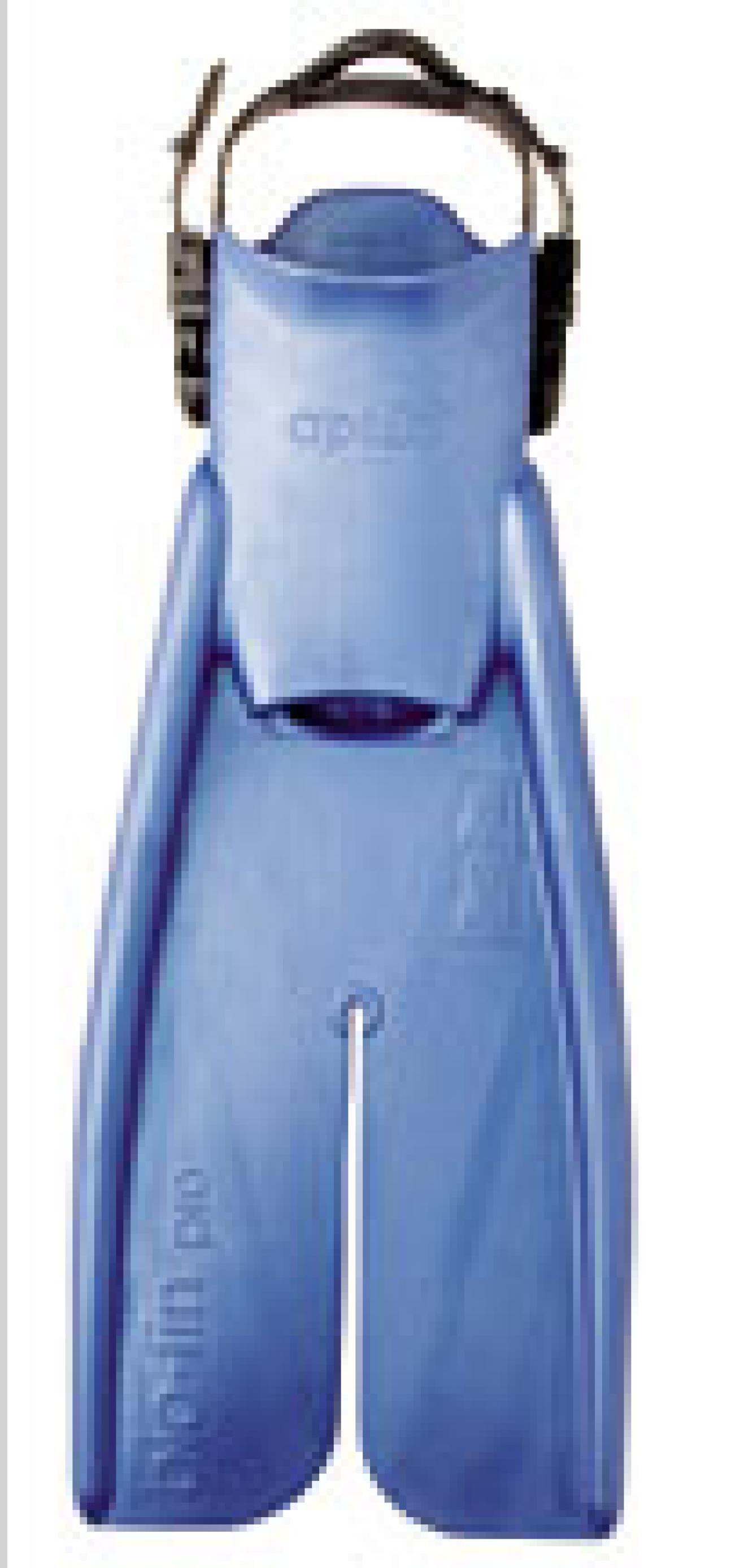
| | Apollo Bio Fin Pro| A top performer in speed, efficiency and real-world diving, Apollo's Bio-Fin Pro earns the title of best overall adjustable fin in this test go-round. The fin is made of all-natural rubber, which not only gives the somewhat smaller fin blade its snap, but also makes it comfortable. The flexible propeller blade can seem somewhat flimsy until you get used to it. But after a little practice, it proves to be an extremely stable, maneuverable fin that moves you through the water with minimal muscle strain. One of the fastest adjustable fins in the flutter kick, the Bio-Fin Pro also generated good speeds using frog and dolphin kicks and ranked among the top fins for towing a diver on the surface.Test divers found the Bio-Fin Pro to have an excellent foot pocket. The fin is very easy to don and doff, especially in the water, helped by a handy open loop on the strap. Its buckles also earned high marks.
PRICE: $190, original black; $200, metallic blue.
FIN STYLE: Split.
BUOYANCY IN SALT WATER: Negative.
FOOT POCKETS: Open toe.
RELATIVE STIFFNESS: Less stiff than average.
BLADE SIZE: Smaller than average.
AVAILABLE SIZES: 5.
COLORS: 2.
MADE IN: Japan.
STRENGTHS: Good range of sizes. Comfortable foot pocket. Ease of kick. Minimal muscle strain. High power vs. stress ratio. Highly maneuverable. Easy to don and doff.
WEAKNESSES: None.
For More Information
APOLLO SPORTS USA (800) 231-0909; web: www.apollosportsusa.com
AQUA LUNG BLADES II
|| |---| |
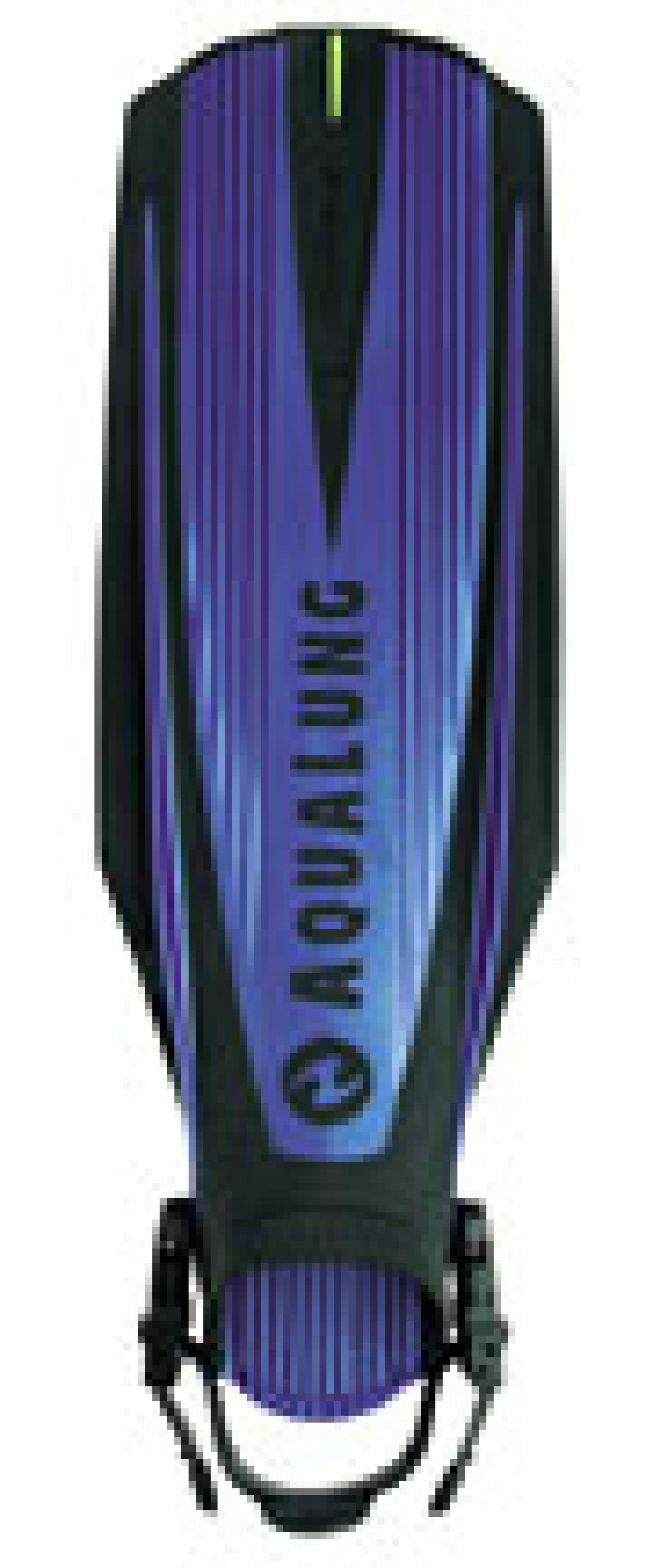
| | Aqua Lung Blades II| Aqua Lung's Blades II is a total redesign of its popular and highly rated Blades fin. Unfortunately, the new combination of polymer plastic and rubber construction found in the Blades II results in what is described as a too-stiff fin with a too-soft foot pocket. Based on test results, this is not a good combination if you're striving for performance.With a fin blade built on top of the foot pocket, the Blades II earns middle-of-the-road scores for speed and alternate kicks, and only marginal scores for efficiency. It takes a lot of effort to move through the water with this fin. It kicks hard and puts undue strain on ankles. In real-world diving, sharp turns and small maneuvers prove difficult with the Blades II, especially for macro photographers. One test diver's comment, "As responsive as a two-by-four," about sums it up.The fin did earn respectable scores in comfort; however, some female divers needed to cinch down hard on even the smallest size to achieve a decent fit. Although it received the second most votes for worst buckles, test divers liked the strap's adjustment button and the large strap tab, which made it easy to don and doff the fin in the water.
PRICE: $120.
FIN STYLE: Paddle.
BUOYANCY IN SALT WATER: Slightly negative.
FOOT POCKETS: Closed toe.
RELATIVE STIFFNESS: Stiffer than average.
BLADE SIZE: Larger than average.
AVAILABLE SIZES: 3.
COLORS: 4.
MADE IN: Italy.
STRENGTHS: Easy buckle operation. Easy to don and doff on deck and in the water.
WEAKNESSES: Only marginally efficient. Buckles can fall off fin posts.
For More Information
AQUA LUNG AMERICA (760) 597-5000; web: www.aqualung.com
AQUA LUNG V-TEK
|| |---| |
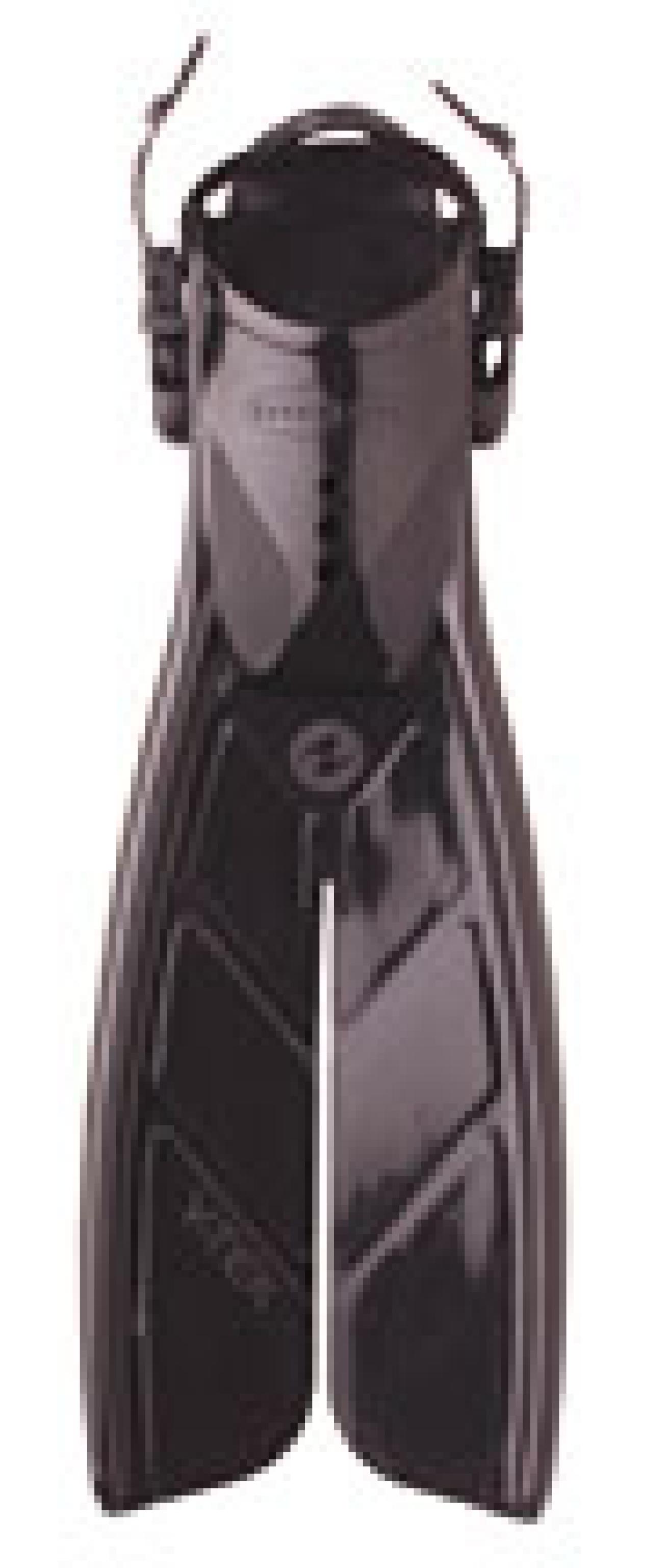
| | Aqua Lung V-Tek| Made from 100 percent polyurethane, Aqua Lung's new V-Tek was able to produce good top speeds, but its efficiency scores were only slightly better than paddle fins. However, strapped on for real-world diving, the V-Tek proves to be responsive and well-suited for delicate maneuvers. While not as stable as some of its competitors (the blades have a tendency to hit each other), it does tend to be a good sculling fin. The closed-toe foot pocket is short and can cause toe cramping. It's also wide, which created fin wobble for our female test divers, who also complained of excessive ankle strain with this fin.The buckle on the V-Tek differs only slightly from that on the Blades II, but with both buckles it's too easy to lose pieces. The female portions, when detached from their male portions, spin freely on the fin posts. When they assume a certain position, they have a tendency to pop off. Picture this happening at a remote dive location--which is exactly what happened to us--twice on the dive boat and once on the dock. Luckily, we were able to retrieve the pieces.
PRICE: $185.
FIN STYLE: Split.
BUOYANCY IN SALT WATER: Negative.
FOOT POCKETS: Closed toe.
RELATIVE STIFFNESS: Less stiff than average.
BLADE SIZE: Smaller than average.
AVAILABLE SIZES: 4.
COLORS: 2.
MADE IN: Japan.
STRENGTHS: Easy to accelerate. Maneuverable.
WEAKNESSES: Limited sizes. Marginally efficient. Buckles can fall off fin posts.
For More Information
AQUA LUNG AMERICA (760) 597-5000; web: www.aqualung.com
ATOMIC SPLITFIN
|| |---| |
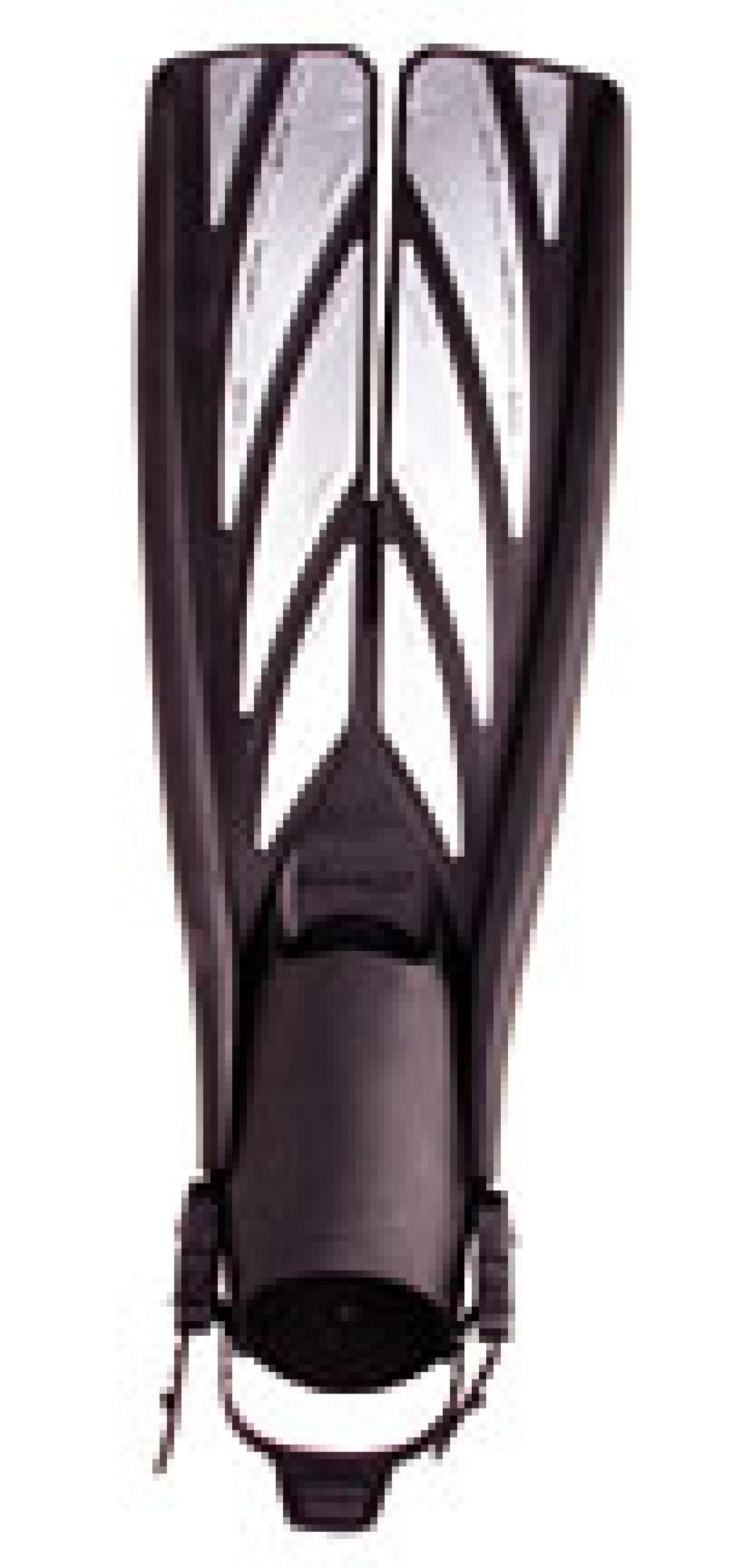
| | Atomic Splitfins| Atomic Aquatics' 2002 silver-blade SplitFin, made of an updated blend of three synthetic rubber compounds and a new plastic injection process, earned good scores for efficiency and high scores for speed and real-world diving, placing the fin solidly in second place in overall standings.Easy to kick but still powerful, you can really get some speed out of this fin. Acceleration is good, especially using the flutter kick. The fin provides excellent stability and maneuverability, great for shooting video or following critters through blue water and around reef structures.While it excels in performance, no other adjustable fin comes close to the scores Atomic earns in fit and comfort. The foot pocket maintains a grip on your foot that virtually eliminates wobble. Even female test divers were able to achieve a good fit. They all agreed that the SplitFin offers the right-sized pockets for a woman's foot.The SplitFin is easy to don and doff, even in the water, due primarily to Atomic's EZ-Lok system. The clear vote winner for "best buckles," rather than coming apart in two pieces, the entire assembly detaches from the fin. To release the buckle, squeeze both tabs together and slip the buckle off the mounting post. To reattach, slide it onto the post where it clicks into place. A very nifty design.
PRICE: $189.
FIN STYLE: Split.
BUOYANCY IN SALT WATER: Slightly positive.
FOOT POCKETS: Open toe.
RELATIVE STIFFNESS: Average.
BLADE SIZE: Larger than average.
AVAILABLE SIZES: 4.
COLORS: 3.
MADE IN: Taiwan.
STRENGTHS: Good efficiency. Very good speed. Excellent fit, sizing and comfort. Excellent acceleration. Outstanding stability. Minimal muscle strain. Easy to kick.
WEAKNESSES: None.
For More Information
ATOMIC AQUATICS (714) 375-1433; web: www.atomicaquatics.com
DACOR PANTHER
|| |---| |
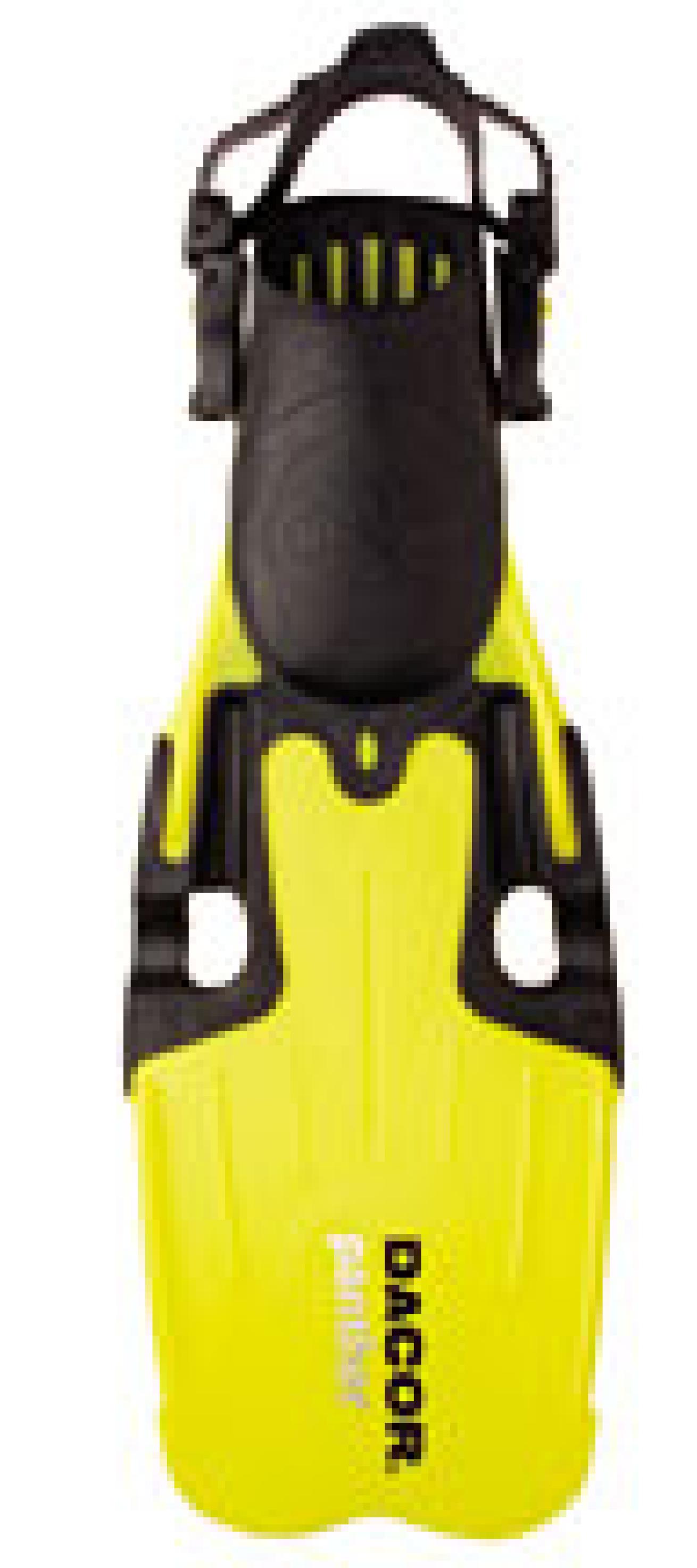
| | Dacor Panther| While generally a comfortable fin, there wasn't much our test divers liked about the Panther. In the water it requires a lot of energy, as evidenced by low power vs. stress scores. The fin provides little control for changing or maintaining speed and it is slow.Featuring an ultralight technopolymer blade and incorporating Dacor's Optimized Pivoting Blade system, the Panther earned the lowest scores in this test group. In efficiency, speed, all fin kicks and real-world diving, the Panther came in at the back of the performance pack.The Panther's buckles also caused problems. Dacor's ABS (Adjustable Binding System) is difficult to use, and can be a real pain in the fingers. But, ironically, if you forget to lock it, it will pop loose at the most inopportune time, like on a giant stride. Fortunately, the strap adjustment button works quite well, because most test divers eventually chose simply to loosen the strap to don and doff the fin, thereby avoiding the buckle system altogether.
PRICE: $149.
FIN STYLE: Paddle.
BUOYANCY IN SALT WATER: Positive.
FOOT POCKETS: Closed toe.
RELATIVE STIFFNESS: Stiffer than average.
BLADE SIZE: Smaller than average.
AVAILABLE SIZES: 3.
COLORS: 2.
MADE IN: Italy.
STRENGTHS: Lightweight.
WEAKNESSES: Limited sizes. Difficult buckles. Slow. Inefficient. Poor power vs. stress ratio. Awkward on surface swims and when towing a diver.
For More Information
DACOR CORP. (203) 852-7079; web: www.divedacor.com
OCEANIC VORTEX V-12
|| |---| |
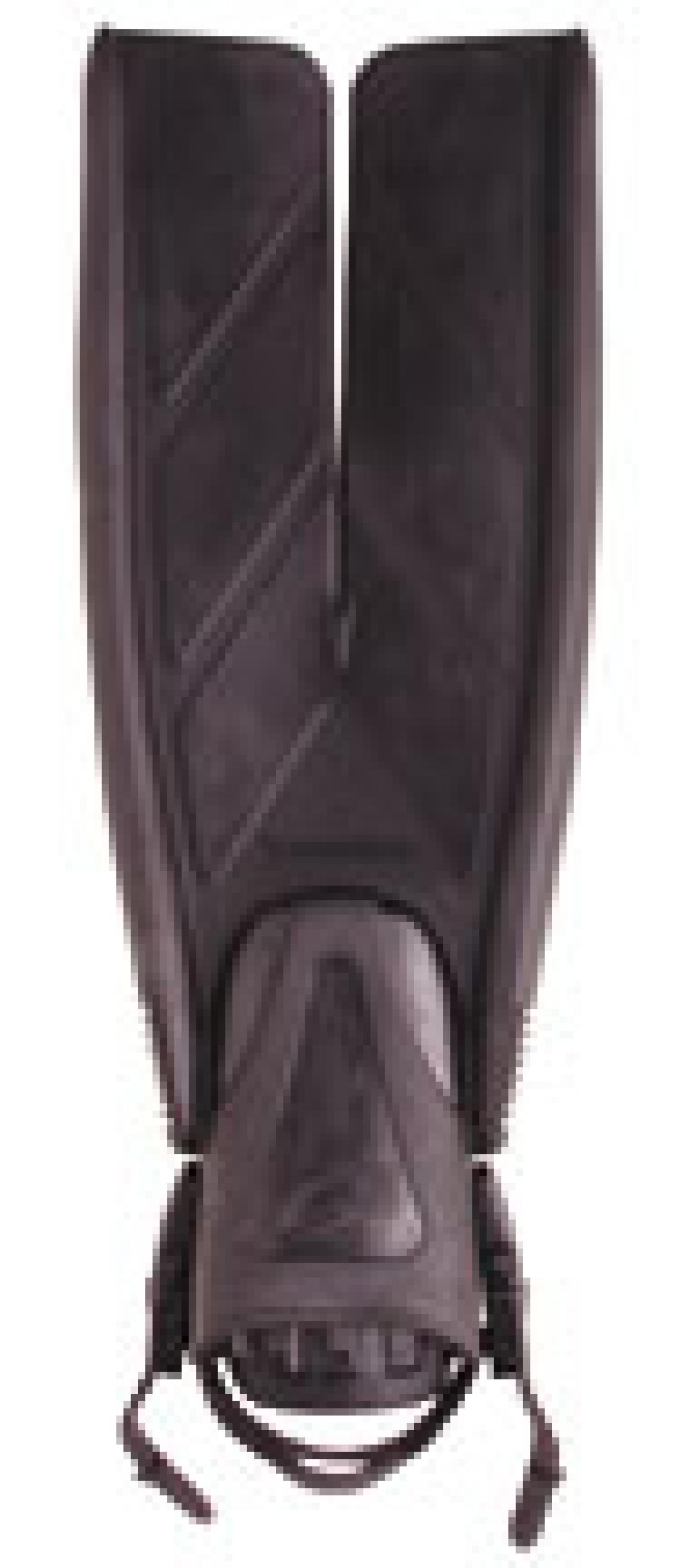
| | Oceanic Vortex V-12 | Oceanic's Vortex V-12 is basically the same fin from last year with the addition of a new buckle design. This is a versatile split fin that scores consistently well in both speed and efficiency. Made of duroprene, Oceanic's own material consisting of natural rubbers and high-tech polymers, the fin is designed with beefy side rails. While the foot pockets are comfortable, they are relatively short and very wide, which caused some fit and stability problems for a number of the female test divers who found even the smallest size to be too large.For those not suffering from fit problems, the V-12 provides exceptional power with minimal muscle strain in real-world diving conditions. Flutter kicks are easy, and the fin provides good close-in maneuverability using only small ankle movements.Oceanic's new buckle design works well, but some divers felt the strap slipped too easily beneath the adjustment button, which created the tendency to overadjust. Obviously, this is a matter of personal preference. Everybody, however, agreed that the large grab loop on the strap is a big plus.
PRICE: $189.95.
FIN STYLE: Split.
BUOYANCY IN SALT WATER: Negative.
FOOT POCKETS: Closed toe.
RELATIVE STIFFNESS: Less stiff than average.
BLADE SIZE: Larger than average.
AVAILABLE SIZES: 3.
COLORS: 1.
MADE IN: Taiwan.
STRENGTHS: Very good speed. Good efficiency. Very maneuverable. Easy to maintain speed.
WEAKNESSES: Limited sizes.
For More Information
OCEANIC USA (510) 562-0500; web: www.oceanicww.com
SCUBAPRO BLACK TWIN JET
|| |---| |
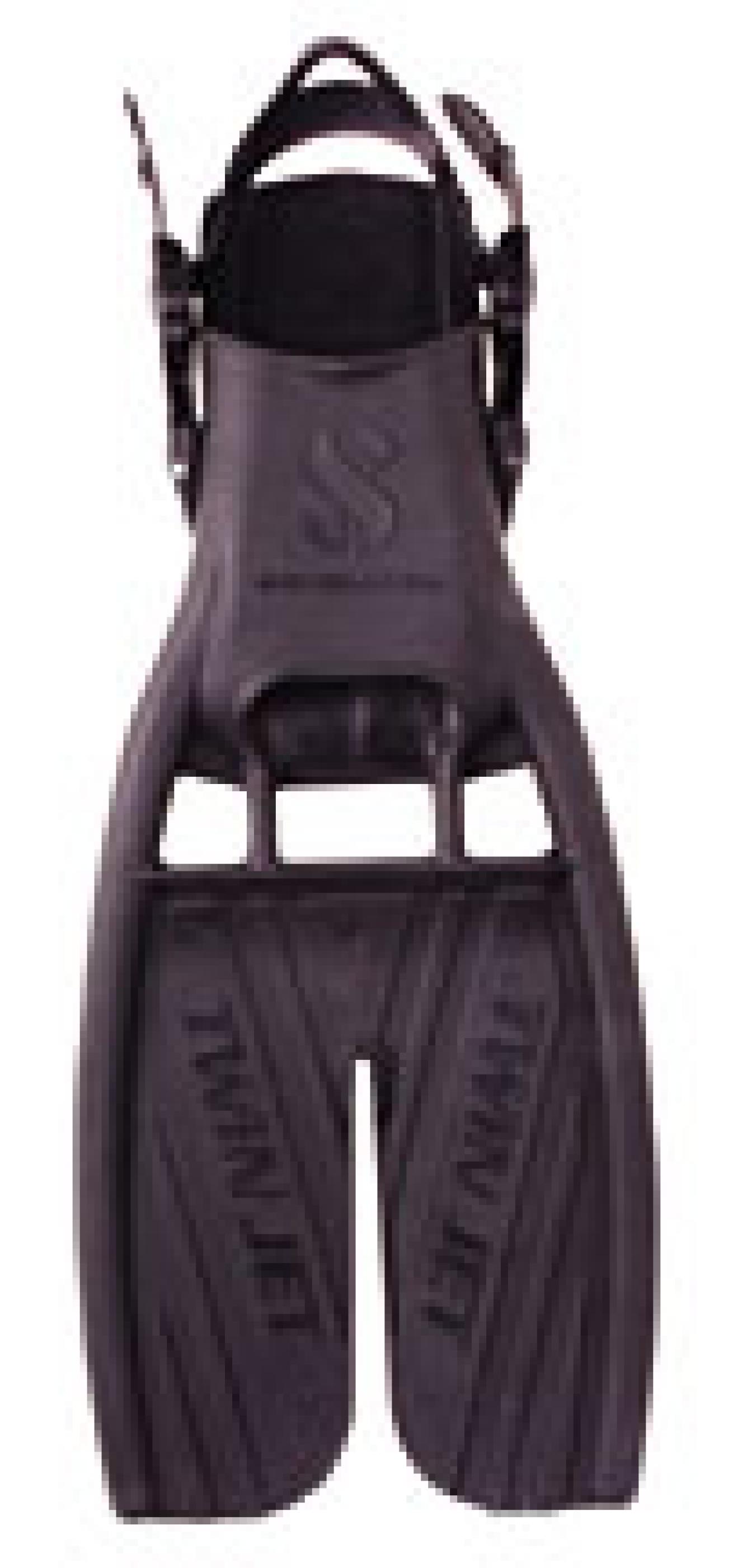
| | Scubapro Black Twin Jet| Scubapro's Black Twin Jet comes to this year's tests with a new swivel buckle. A stainless-steel pin secures the assembly to the fin, eliminating the possibility that it will accidentally pop off. The buckle locks together with a positive snap; however, you have to line the pieces up just right, or the spring-loaded prongs don't want to insert. The Black Twin Jet produced good efficiency performance. Subjective tests bear this out with excellent scores earned in ease of kick and muscle strain. But where the fin excels is in maneuverability. Real-world diving shows the Black Twin Jet to be great for getting in and out of tight spaces and is easy to change direction.The Black Twin Jet didn't fare as well in the areas of fit and comfort, which may have been the cause for its slower-than-expected speed runs, which brought down the fin's overall scores. The large, somewhat stiff foot pocket is designed primarily to accommodate thick neoprene booties or dry suit boots. (Indeed, the foot pocket received no negative comments in previous tests performed in temperate waters.) However, in our tropical test environment, it caused some discomfort for a number of test divers. Fortunately, the Twin Jet is available in other styles (Graphite, Cobalt and Hi-Viz) that are made from a softer, more flexible material better suited to tropical diving. All styles, including the black, have earned Testers' Choice designations in previous tests.
PRICE: $189.
FIN STYLE: Split.
BUOYANCY IN SALT WATER: Negative.
FOOT POCKETS: Open toe.
RELATIVE STIFFNESS: Average.
BLADE SIZE: Average.
AVAILABLE SIZES: 4.
COLORS: 1.
MADE IN: USA.
STRENGTHS: Good efficiency scores. Easy to kick. Minimal muscle strain. Outstanding maneuverability.
WEAKNESSES: Uncomfortable foot pocket.
For More Information
SCUBAPRO (619) 402-1023; web: www.scubapro.com
TUSA SF-8 X-PERT ZOOM/BLACK
|| |---| |
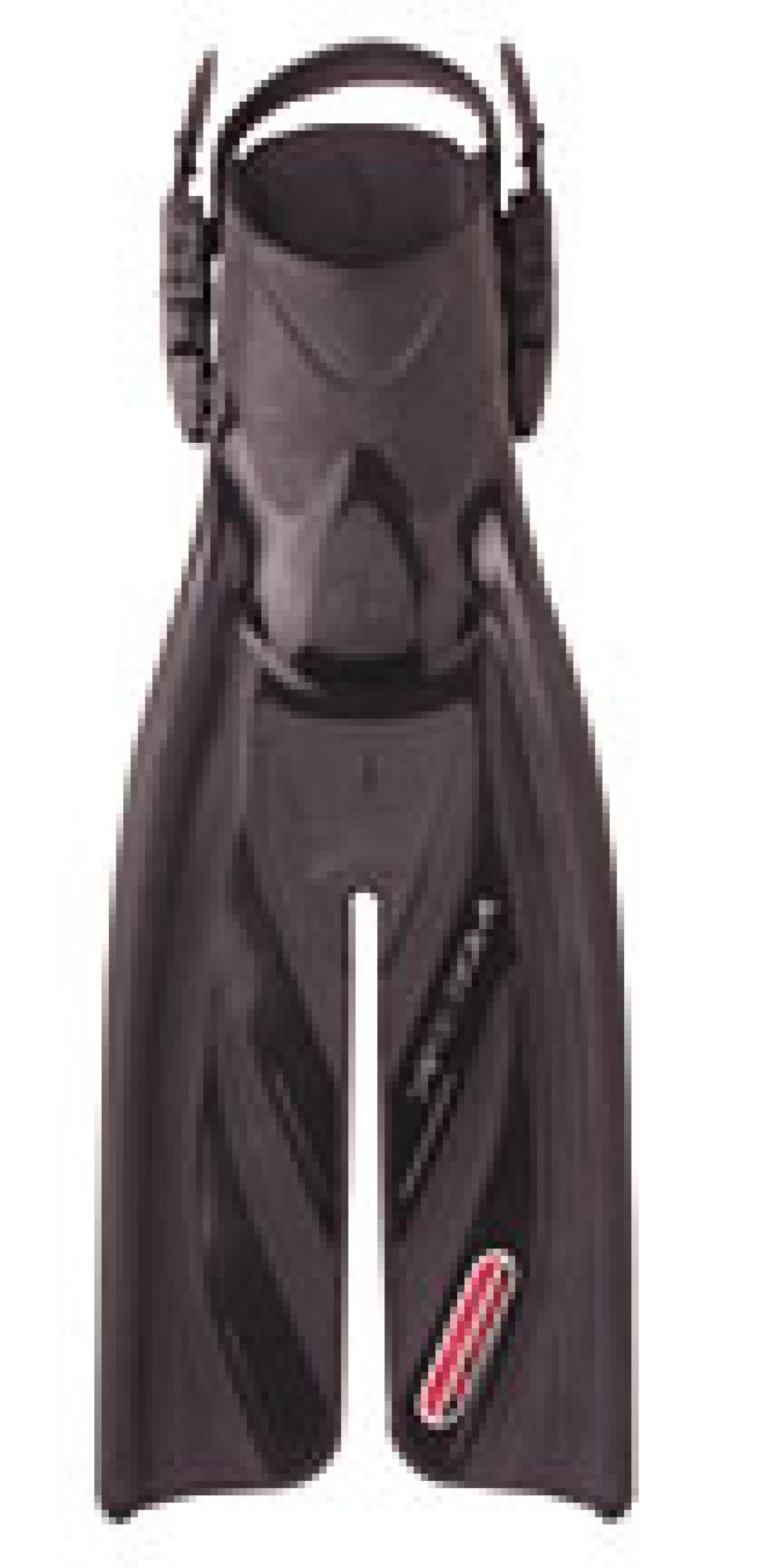
| | TUSA SF-8 X-Pert Zoom | A new compound used on this year's Black X-Pert Zoom makes it one of the stiffer split fins in this test go-round. (Black Zooms are traditionally made with a stiffer compound than other Zooms.) The sharp downward angle to the blade maximizes kick efficiency in the water but makes it hard to walk on deck. It helps that the blade is positioned on top of the foot pocket.While generating re-spectable scores in both speed and efficiency, the X-Pert Zoom ranks quite well in real-world diving. The fin is relatively stable, easy to kick and maneuverable. Although efficient in the flutter kick, performance using frog or dolphin kicks is only fair.The fin also scored well for general comfort, although like other closed-toe designs, the pockets are a little short relative to width. Straps adjust well, buckles swivel and detach with ease, making it easy to take the fin off in the water. However, the female portion of the buckle, when detached from its male portion, spins freely on the fin post and can accidentally pop off, a potential dive-wrecker.
PRICE: $189.
FIN STYLE: Split.
BUOYANCY IN SALT WATER: Positive.
FOOT POCKETS: Closed toe.
RELATIVE STIFFNESS: Average.
BLADE SIZE: Smaller than average.
AVAILABLE SIZES: 3.
COLORS: 5.
MADE IN: Taiwan.
STRENGTHS: Easy to don and doff. Maneuverable. Stable. Minimal muscle strain.
WEAKNESSES: Hard to walk on deck. Buckles can pop off fin posts.
For More Information
TUSA (562) 498-3708; web: www.TUSA.com
Full Foot-Fins
Past Full-Foot Performers
These full-foot fins received Testers' Choice awards in previous fin tests and are still on the market.
OCEANIC VORTEX V-6
SCUBAPRO TWIN JET FULL FOOT/BLACK
AERIS VELOCITY
|| |---| |
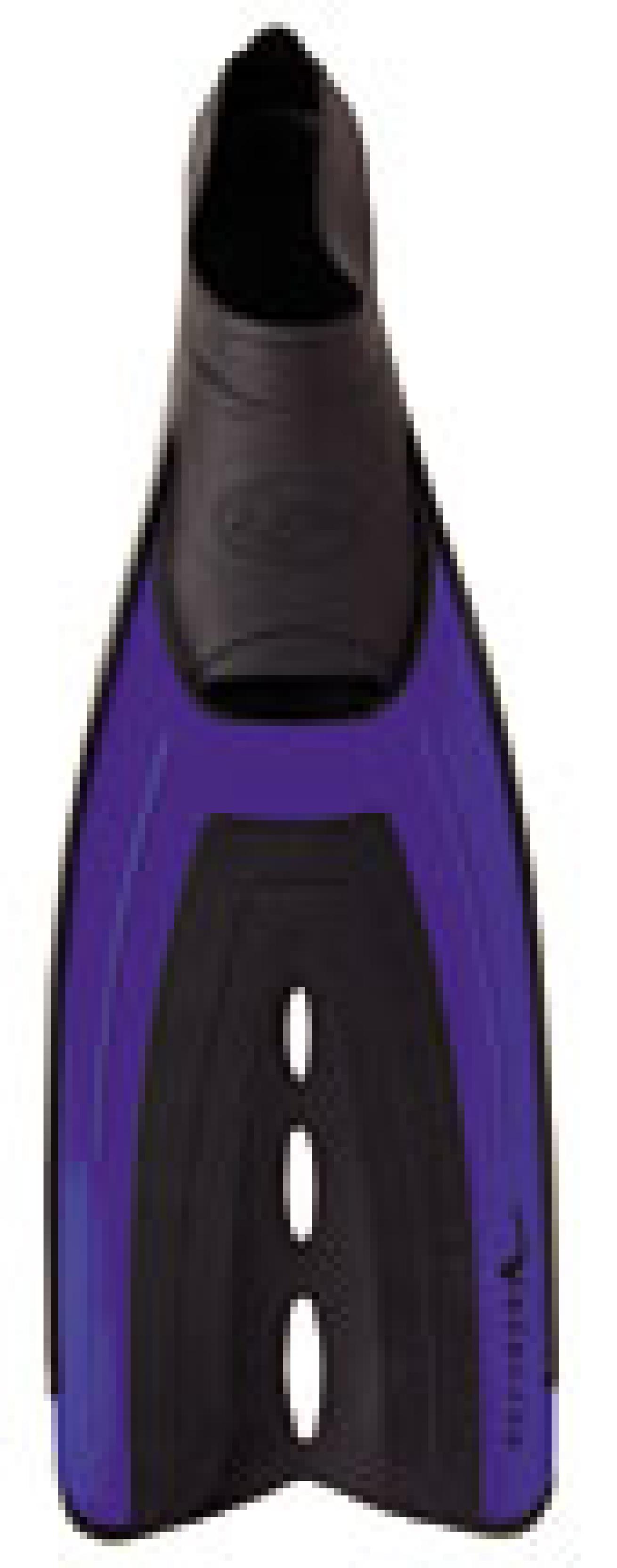
| | Aeris Velocity | A full-foot version of Aeris's successful Velocity adjustable, the polypropylene blade on this brand-new fin is positioned beneath the foot pocket and sports a slight downward angle. The result: very good speed, efficiency and alternate kick scores as well as the best subjective scores of all full-foot fins in this test go-round.This fin dives like a dream. It's easy on the legs, highly maneuverable and provides effortless propulsion. It also has outstanding power vs. stress rates and easy-to-maintain speed. The fin is deceptive; it requires so little effort it sometimes doesn't seem like it's doing much, but in fact it's moving you right along. Most efficient with the flutter kick, it's also an excellent sculling fin and efficient with other kicks.While universally considered a very comfortable fin, the few negative comments directed to the Velocity related to size and fit. But at the time of the tests, Aeris had only two sizes available, (9/10 and 10 1/2-11 1/2). The test divers with the problems were those whose feet didn't properly fit these choices. Aeris has since expanded the line to seven sizes--more than any other full-foot in this test group--which ought to solve any size and fit problems.
PRICE: $49.95.
FIN STYLE: Paddle.
BUOYANCY IN SALT WATER: Negative.
FOOT POCKETS: Open toe.
RELATIVE STIFFNESS: Less stiff than average.
BLADE SIZE: Smaller than average.
AVAILABLE SIZES: 7.
COLORS: 3.
MADE IN: Italy.
STRENGTHS: Price. Wide range of sizes. Lightweight. Very good speed
and efficiency. Effective using all kicks.
WEAKNESSES: None.
For More Information
AERIS (510) 346-0010; web: www.diveaeris.com
OCEANIC CARIBE
|| |---| |
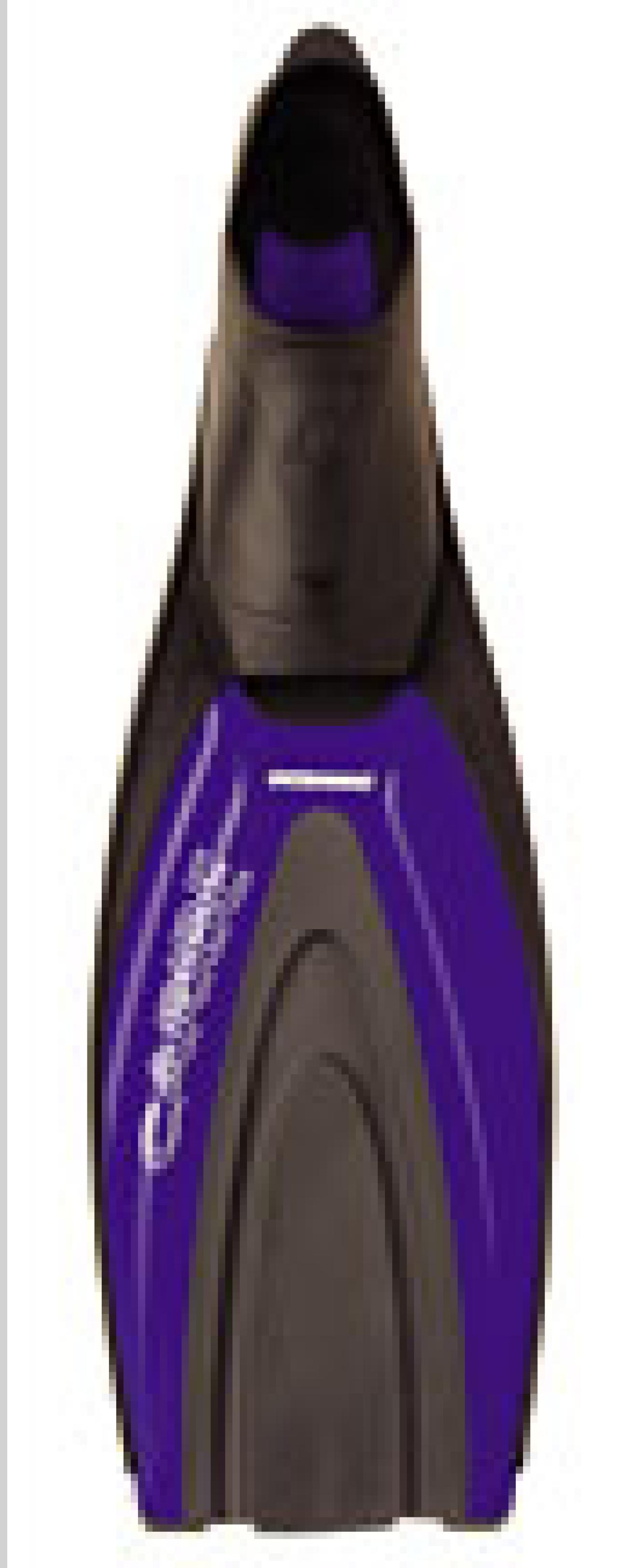
| | Oceanic Caribe| The bar-none best performing fin in this test go-round, the agile Caribe from Oceanic is simply a marvel of engineering. Incorporating a paddle blade with a pliable center panel flanked by polymer ribs, with this fin, a little power in equals a lot of power out. It is also very efficient.
Seems there's nothing this fin can't do. Among the best with alternate kicks, and the best at towing divers, it's a great open-water fin and an even better reef fin. With excellent acceleration, great cornering and superb stability and control, as one test diver quipped, "It shouldn't be this easy to propel oneself through the water."
While male divers fell in love with the Caribe, female divers remained somewhat cool. But this was due primarily to problems with fit and the corresponding difficulties of donning and doffing the fins on deck and in the water. In fairness, test divers had access to only three of the six available foot pocket sizes. With a full complement of sizes available, fit problems as well as donning/doffing would have presumably solved themselves.
PRICE: $45.
FIN STYLE: Paddle.
BUOYANCY IN SALT WATER: Negative.
FOOT POCKETS: Open toe.
RELATIVE STIFFNESS: Less stiff than average.
BLADE SIZE: Smaller than average.
AVAILABLE SIZES: 6.
COLORS: 3.
MADE IN: Italy.
STRENGTHS: Price. Lots of available sizes. Lightweight. Fast. Efficient. Comfortable. Stable. Maneuverable.
WEAKNESSES: None.
For More Information
OCEANIC USA (510) 562-0500; web: www.oceanicww.com
SNORKEL FINS? You Gotta Be Kidding!
In case you missed it, let's be clear: three "cheap snorkel fins," as one tester called them, whipped all of the pricey adjustable fins by a significant margin in our tests for speed and efficiency.
These three full-foot paddle fins (costing between $45 and $68) also scored better than average in subjective scores: two of them scored near the top (Aeris Velocity = 4.0, Oceanic Caribe = 3.9).
Could this be a fluke, some weird error in the testing? Not when both objective tests and the subjective evaluations of 12 divers all agree. This is real.
Why are these full-foot paddle fins so much faster and more efficient? Frankly, we're not sure, but here are some possibilities:
They are much lighter. "Snorkel" fins weigh about one pound per fin, compared to about one-and-a-half pounds for the adjustable paddles and two to three pounds for the adjustable splits. (Split fins pay an extra weight penalty for their thick side rails.) The adjustable fins need booties, too: add maybe another half-pound each. Extra weight costs energy when each fin stroke means accelerating a fin, stopping it, accelerating it in the other direction, stopping it again. (Imagine trying to run fast wearing two-pound ankle weights.)
They are more streamlined. Full-foot fins lack the straps with dangling ends that cause drag. Remember, the fins are moving in the water even faster than you are. Though it's mostly up and down action, it still causes drag.
They grip your foot more firmly. The full-foot fin grips your entire foot from toe to heel, giving a more efficient transfer of energy from your foot to the fin blade. By contrast, even the best-fitting adjustable fin makes a spongy connection to your foot. The bootie, for example, is a foam cushion. A particular problem is the fin stroke toward the surface when you are swimming face-down. Here, the adjustable fin depends on the leverage between your toe and the top of your instep where it contacts the foot pocket through your bootie. As a result, the adjustable fin's blade lags slightly behind the movement of your foot.
All three advantages--light weight, streamlining and grip to your foot--are especially important with the rapid short kick cycle now understood to be most efficient. The small and fairly flexible blades of these fins seem to work well with that kick too.
BOTTOM LINE: SPLIT OR PADDLE?
The split design still seems to be superior, other things being equal. Among the adjustable fins we tested, splits clearly outperformed paddles. We haven't yet seen a full-foot split fin as small and light as these full-foot paddles, but last year the full-sized Scubapro Twin Jet full-foot fin performed extremely well.
BOTTOM LINE: FULL-FOOT OR ADJUSTABLE?
The full-foots performed better but have some real-world drawbacks. If they fit as they should, they are harder to put on and take off (especially in the water). Climbing boat ladders and walking decks barefoot may be uncomfortable. In cold water, your tootsies will freeze.
But a surprising number of experienced tropical divers and divemasters already use them. Because they are small, they pack well for travel.
One caution: Don't assume all inexpensive snorkel fins will perform equally well. Fin performance is a surprisingly complex result of size, shape, stiffness and who knows what else. The designers of the three we tested seem to have got it right, but another fin that looks superficially similar may perform poorly.
In Appreciation
Many thanks to Bayman Bay Club for their help and hospitality, to Scubapro for the loan of air-integrated dive computers, to Polar USA for the loan of heart monitors, and to Cetacea Diving Products for providing underwater slates and other equipment for the tests.

